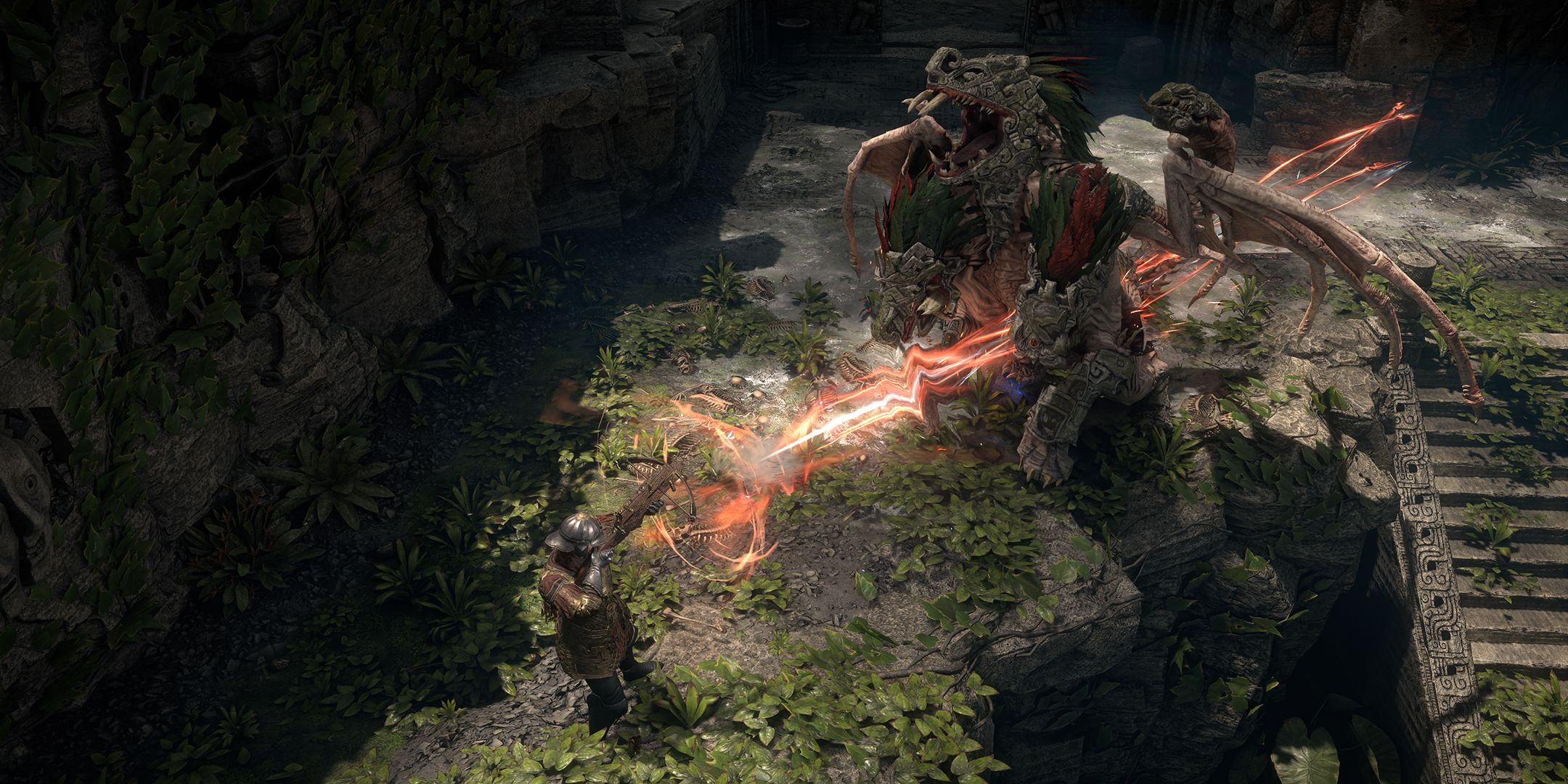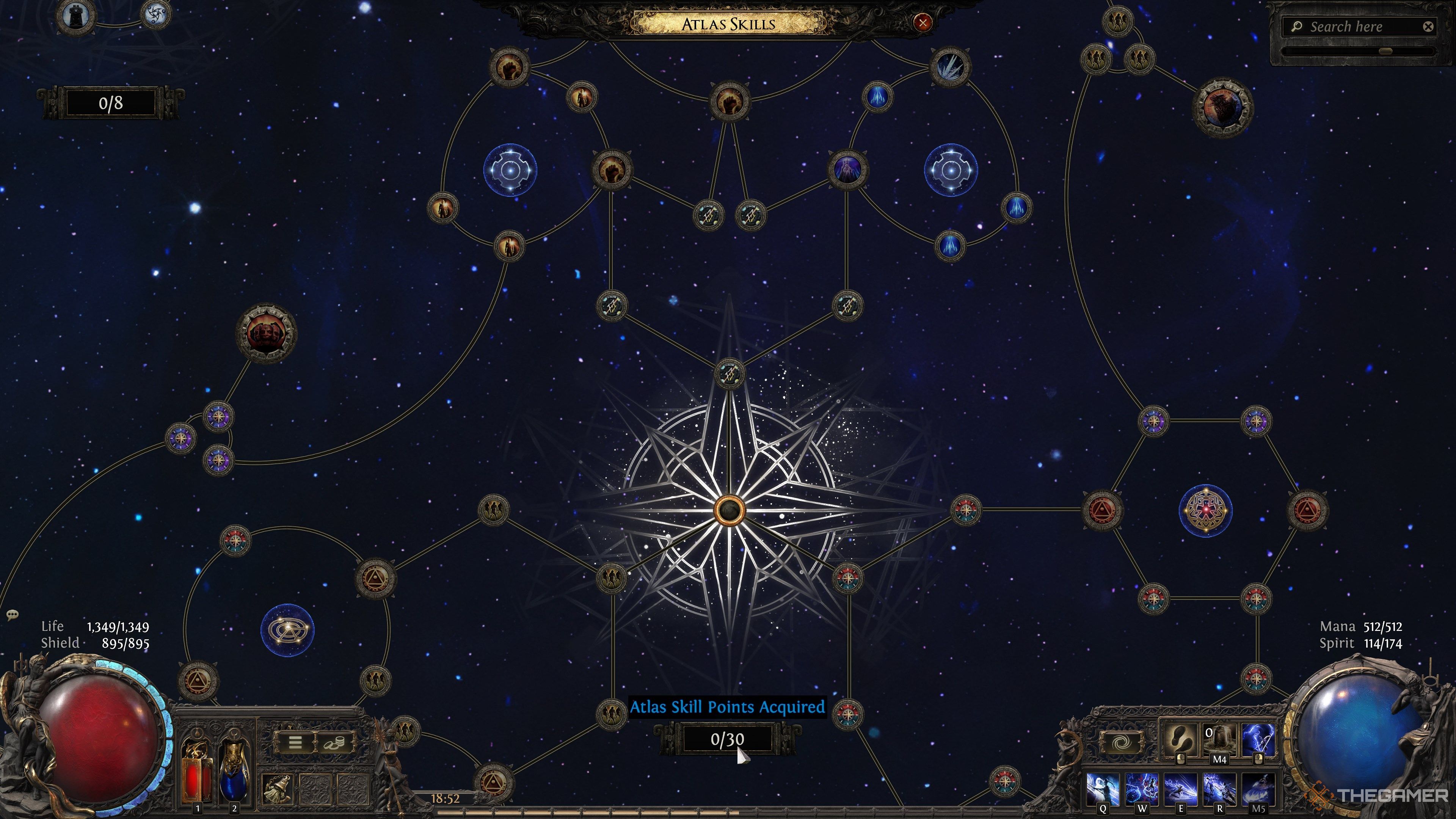Quick Links
Path of Exile 2
has made major iterations to its endgame system compared to its predecessor. Once you’ve completed the endgame, you’ll gain access to a massive Atlas of endgame tilesets and mechanics. Use your Waystones to chart a path through the Atlas to rebuild Wraeclast and cleanse the corruption that’s now plaguing the land.

Related
Path Of Exile 2: Weapon Set Points, Explained
Here’s everything you need to know about how Weapon Set Passive Points work in Path of Exile 2.
Mapping is a core part of the PoE experience, and the sequel is no exception. With that said, GGG have made some major changes to progression and league mechanics in this installment that you’ll want to be informed of before you sink your teeth into the endgame. In this guide, we cover how the Atlas works in PoE2, how its unique passive trees work, and give some general tips to help you sustain Waystones.
Changes From Path Of Exile
What Is The Atlas?
The Atlas is an endgame progress system that you gain access to upon completing the PoE2 campaign. In Early Access, that includes the game’s first three Acts on both Normal and Cruel difficulties. Once you finish the campaign, speak with Doryani in the Ziggurat Refuge to start the endgame questline.
Both the Ziggurat Refuge and your personal hideout will have a Map Device. Interacting with this device will bring up the Atlas of Worlds, a sort of 2.5D tabletop with a sprawling series of tilesets you can clear. Select an adjacent tileset you wish to clear, insert a Waystone to create the map, and clear it to progress through the Atlas.
Atlas Map
Interacting with any Map Device or opening the “Endgame” tab of the world map will bring up the Atlas board. It might look intimidating at first glance, but it’s a surprisingly easy system when you break it down.
You’ll start inside a ziggurat structure near the middle of the board. Surrounding the ziggurat are a collection of small circles you can click on. These are maps or tilesets you can clear. The glowing, blue circles are adjacent to your location on the Atlas and can be selected. Any unlit circles are too far to reach; you’ll need to progress through the Atlas and get closer.
Selecting a glowing node will bring up a small inventory. This is where you place your Waystone, a consumable item you’ll start earning towards the end of PoE2’s campaign. Think of it as a currency required to participate in the endgame. Socket the Waystone into the inventory, select “Traverse,” and use one of the six available portals to clear the map. Claim your rewards and repeat the process to slowly chart a path through the entire Atlas.
You get one life per map, even in Softcore. Be careful.
Waystones
Waystones are consumable items required to participate in PoE2’s endgame content. You’ll start finding Waystones around Cruel Act 3 by slaying monsters. Be sure to grab them whenever they drop. As you reach the edges of the Atlas and kill tougher monsters, you’ll earn higher-tiered Waystones.
As with most items in Path of Exile 2, you can modify Waystones with currency orbs. They can be upgraded to Magic or Rare quality, adding affixes to the item that make the map drastically harder. In exchange, you’ll earn bonuses to the map’s monster pack size, item rarity, and Waystone drop chance. If you can handle the added difficulty, it is always worth upgrading your Waystones before using them; don’t run white-rarity Waystones if you can help it.
Map Mechanics
Some of these nodes will have icons floating above them. These denote unique mechanics tied to that node, usually called League mechanics by the community. For example, the Wetlands node pictured above has three icons: a Breach hand, a Delirium monster, and Corruption. This tells you that all three modifiers will be present the next time you insert a Waystone into this tile.
There are six potential map modifiers you’ll find as you explore the Atlas:
|

Boss |
This map has a Unique boss. Kill them to complete the map. |
|---|---|
|

Breach |
Ethereal hands appear on the map. Walk over them to start a demonic invasion. Kill demons to extend the invasion timer. Slain monsters can drop Breach Splinters. |
|

Corruption |
This map contains more modifiers than usual, making it significantly more difficult. Killing monsters in close proximity will spawn Beyond demons. |
|

Delirium |
Fog envelops the map, empowering all monsters within. Increases enemy density. The fog disappears over time. Kill enemies within the fog to earn reward caches. Applying a Delirium orb to a Waystone adds permanent Delirium fog but makes the map significantly harder. |
|

Expedition |
Use explosives to uncover buried treasure and monsters. Excavations can uncover Logbooks, leading to Expedition-exclusive maps and valuable rewards. |
|

Ritual |
Bone altars will appear around the map. Interact with them to summon waves of monsters. Clearing a ritual awards Tribute. You can use Tribute to purchase items from altars. The more Ritual altars cleared, the more Tribute you’ll earn. |
Lost Towers And Precursor Tablets
You can influence which modifiers appear on tiles through Lost Towers. Conquering the tower will clear all nearby fog-of-war on the map, letting you see further into the Atlas board. However, if you click on the Lost Tower after it’s cleared, you’ll notice that it has an inventory that’s not too dissimilar from those map nodes. You can insert Precursor Tablets into the Lost Tower to modify a set number of tilesets nearby, lasting for a set number of runs.
Precursor Tablets are themed around league mechanics and tend to drop from those same mechanics. For example, if you want to spawn more Breaches in your maps, you’d want to clear maps with Breach nodes to earn Breach Precursor Tablets. As with Waystones, you can use currency orbs on Precursor Tablets to modify them.
Endgame Atlas Mechanics
Some of the map mechanics we mentioned earlier interact with some of the more obscure parts of the Atlas map, all of which we outline below:
- Breach Splinters create Breachstones. Insert these into The Realmgate structure on the Atlas map to start a pinnacle boss encounter.
- Expedition clears can grant Logbooks. Use these to create Expedition-exclusive maps filled with treasure.
- Ritual has a unique boss encounter: the King of the Mists.
- Delirium can drop splinters of Simulacrum, a wave-based map covered in Delirium fog. Stay alive to earn increasingly more exotic rewards.

Related
Path Of Exile 2: Monk Class Guide
Strike swiftly with one of Path of Exile 2’s new classes: the Monk.
Atlas Passive Tree
Passive trees are an iconic part of Path of Exile, so it should be no surprise that PoE2’s endgame comes with its own suite of passive trees. As you progress through the Atlas, you’ll start unlocking passive points for the dedicated Atlas tree. Press “Ctrl” and “U” on PC to bring up the menu.
You can reallocate your Atlas passive points at any time by speaking with Doryani in the Ziggurat Refuge or your hideout. Refunding Atlas points will incur a small Gold free, similar to reallocating character passives.
Unlike the previous installment, you’ll notice that the Atlas tree in PoE2 is broken up into multiple, much smaller trees. Each passive tree represents a unique mechanic.
|
Tree |
Point Allowance |
Stats |
|---|---|---|
|
Core Atlas Tree |
30 |
Pack Size, Waystone Drops, Essences |
|
Boss |
10 |
Map Boss Difficulty, Boss Drops |
|
Arbiter |
8 |
Arbiter Difficulty, Arbiter Rewards |
|
Breach |
8 |
Breach Pack Size, Splinter Quantity, Breach Boss Modifiers |
|
Delirium |
8 |
Fog Duration, Delirium Rewards, Monster Difficulty |
|
Expedition |
8 |
Logbooks, Explosion Modifiers, Expedition Chests |
|
Ritual |
8 |
Ritual Difficulty, Pack Size, Tribute |
You will earn points for each tree by completing pinnacle fights and endgame maps tied to each mechanic. For instance, completing the Crux of Nothingness encounter in Breach will award Breach passive points. You can hover over your point allowance under each tree to see what objectives you need to complete to earn more points.
Atlas Tips
- Spec your tree for Waystone drops. Waystones are your lifeline for PoE2’s endgame and are surprisingly scarce. Focus on buffing their drop rate through your Atlas tree when starting out.
-
Always upgrade your Waystones. This will buff monster drop rates, enemy pack size, and Waystone drop rates while mapping.
- You should at least use a Transmutation and Augmentation on each Waystone.
- Clear Lost Towers to reveal the fog of war on the Atlas map.
- Slower builds should focus on Expedition. It’s a mechanic you can take at your own pace and is highly rewarding.
- Clearspeed builds should focus on Breach. This mechanic has incredible enemy density in PoE2, making it a great source of XP.





















Leave a Reply